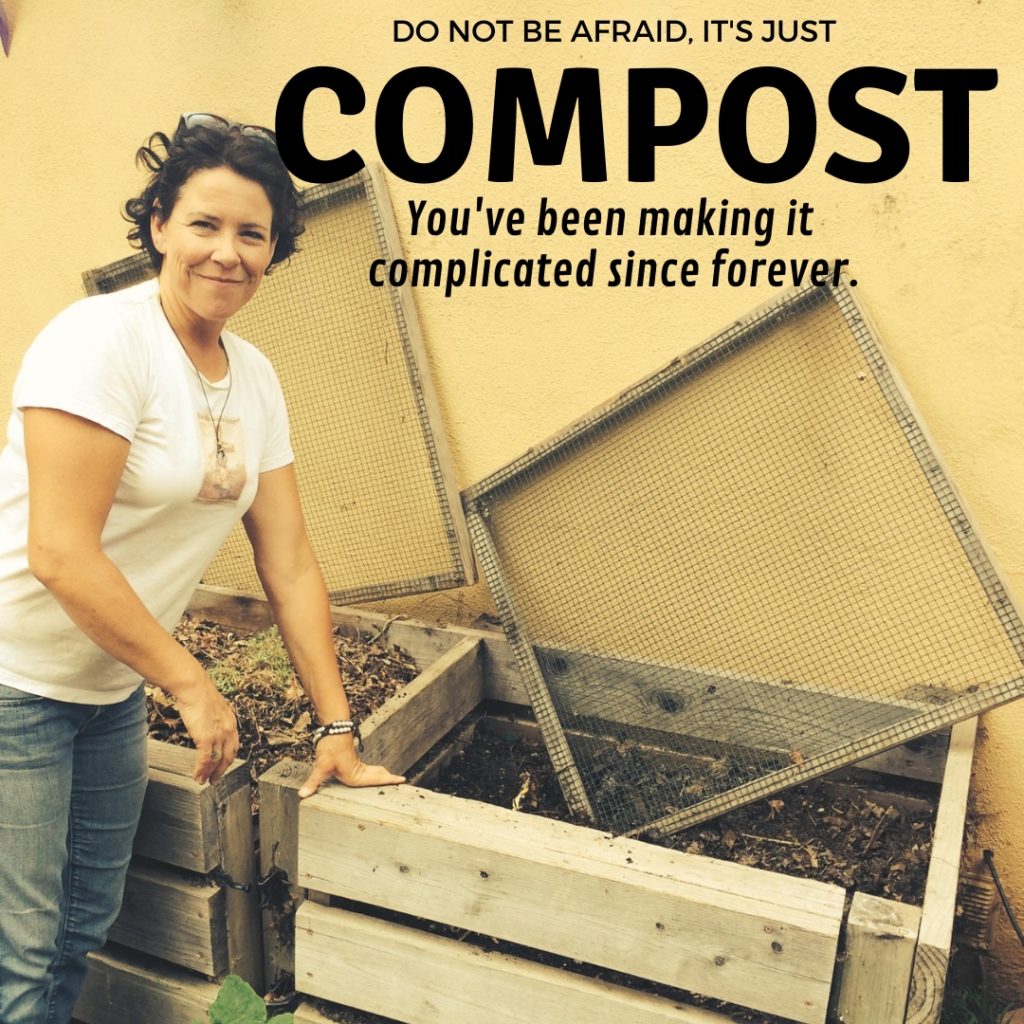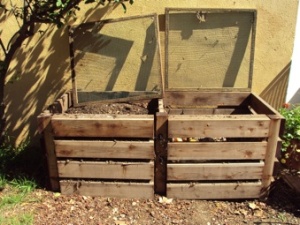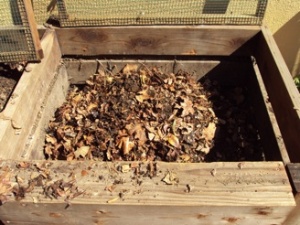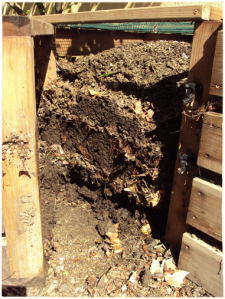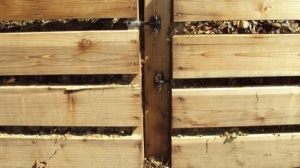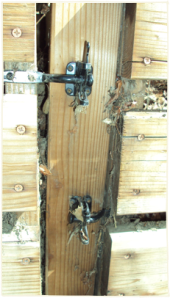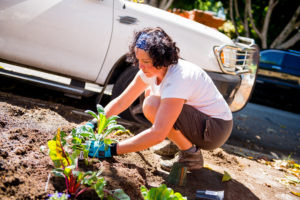Compost 101
5August 16, 2012 by Hope Gardens
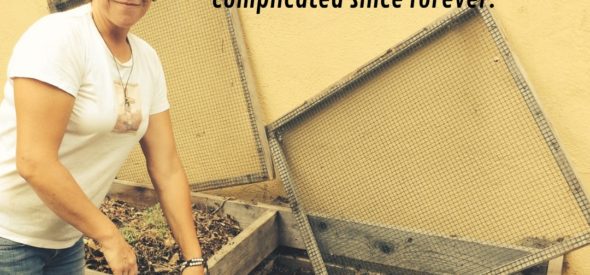
Composting is confounding to a lot of people. Let’s see if we can clear the air and get everyone composting by answering some common questions.

Will my compost bin smell?
This is the most common question I get. There are people who dedicate the better part of their lives to their compost bin. They take its temperature, strictly regulate its diet, feed it expensive activators. For me and my ten jobs and my lackadaisical ways, composting is generally a gaseous affair. It has its own unique smells (rotten eggs) and occasional un-refined sights (slugs, cut worms, maggots). But the result is free, gorgeous, alive, nutrient-delivering soil that keeps my vegetable garden thriving, and my kitchen and yard scraps working for me. There are definitely ways to contain the sweet smell of success to the bottom of the bin and that leads us to the next question:
Is composting a lot of work?
Compost needs maintenance. It needs to be watered and aerated. You need to gather brown materials regularly to cover your kitchen scraps. But everything worth doing is worth doing well, right?
I find composting to be a real return-to-the-earth encounter. The only thing I’ve found to be a more humbling experience than turning the compost bin has been cleaning the kids’ hamster cage –whose soiled bedding, by the way, goes right into the compost bin! (The hamster’s, not the kids’!) Sure, some folks will tell you they just roll their compost around in one of those plastic ball bins and it comes out perfect, but that has just not been my experience. Compost takes effort, but the effort is well-rewarded.
How do I get set up?
I like a wooden 2-bin composter (a 3-bin is great too)
that sits directly on the ground. It needs to be within the reach of a hose and close enough to the house that you can easily carry your kitchen scraps to it. You will need a closeable container
to store your kitchen scraps in. You also need to have a source of brown materials (fallen leaves, for example) and I recommend some bins/trash cans/a wheelbarrow and a shovel to help you transfer the materials to and from the bin during “turning.”
What is compost exactly?
Compost is a mixture of natural (organic) ingredients that heat up and then break down into a perfect planting mix. Those ingredients can be quite varied and there is an extensive list at the end of this blog, but for the purpose of explanation (and to keep expectations realistic) we are going to stick with the basic materials.
Your first main ingredient will be “green” materials. These are your kitchen scraps, coffee grounds and fresh grass clippings.
I think of these as “new” materials; they have not quite begun to break down yet. Do NOT put meat or dairy in your compost. This breeds maggots. I do not put any cooked food in my bin, just to make sure no meat or dairy sneaks in there.
The second main ingredient will be “brown” materials: fallen leaves, cut branches, plant debris, old soil and old grass clippings. You need much more brown materials than green. A 4:1 ratio is ideal. Brown materials are best when slightly wet. Some people soak their brown materials…especially brown paper bags.
Hint: to keep a steady amount of brown materials available, I keep a big pile of leaves in the corner of my yard. I just keep raking more leaves on top of it. When I water the compost, I also soak the leaf pile. What’s great is that this big leaf pile is just over there in the corner, doing its thing, composting away, ready whenever I need it.
What’s the process?
I have a small bin under my sink for my kitchen and household waste. When this little bin fills up, I take it out to my compost bin and toss it on top of the “new materials” side of the bin.
Then I put a couple wheelbarrows-full of brown materials on top of the scraps. This is where the 4:1 ratio comes in. I try to put 4x as much brown material into the bin as I put green materials.
It’s best to cover your scraps immediately if you can. That way vermin (animals and flies) don’t start investigating your compost. This practice also keeps your compost bin from becoming smelly. Then I finish it all off with a good soaking from the hose.
What about the turning?
This is where the two-bin system comes in to play and makes “turning” so much easier and effective.
The main benefit of the double bin is that older compost can live on one side while the new scraps get dumped on the other. This way, your older compost breaks down and cures at the same rate, and when you dig it out, you won’t have fresh decomposing scraps to deal with.
So, when both sides of your bin are full of compost (one side more decomposed than the other), you dig out your finished compost. You will need to sort through it with your hands and throw un-composted stuff back into the compost bin.
Hint: I keep a bunch of those home improvement store paint buckets around to store compost in until I’m ready to use it.
After you get your finished compost out of there, you will then move your newer compost to the now empty bin. You will accomplish this by muscling aka shoveling it out.
Since the compost is not broken down yet, the digging is quite challenging. Some people like using a garden fork. Sometimes I use my gloved hands. (You will quickly learn why it is important to break down long sticks and twigs. Your compost is impossible to move when filled with these cobwebbing through your pile.)
With your shovel or fork or hands, you will move the entire bin of compost to the other side. This way your fresh scraps that were on the top of the pile will end up at the bottom of the bin, exactly where you want them, to speed up the process, and that will put your soon-to-be-finished compost back at the top. And now you have one bin empty bin ready for your freshest scraps. This is how I “turn” my compost. I try to do it every couple months. I give my bin a good soaking at this point.
What about bugs?
Some of you are a little squeamish about bugs.You will need to put on your big boy and big girl garden gloves and remove slugs, snails and cutworms from your compost.

The cutworm. This one is slightly brown in appearance. Mine are usually whiter with a red mouth. All in all, grosser.
A word on cutworms. These are not earthworms (which receive a place of honor in the composter and the garden) but the larvae stage of the black moth. Cutworms are destructive in your vegetable garden, they attract vermin and they are totally disgusting.
Pick them out of your bin (and your garden) and leave them somewhere far away from your garden, bin or yard in general. If you leave the cutworms or their innards (don’t squish them) around your bin or garden, possums and raccoons will thank you by digging around where you don’t want them to.
If you have a lot of ants in your compost bin, use Diatomaceous Earth. I had a major ant infestation and so I did more turning, added the DE and added more brown materials to my bin. After about three cycles of this, the ants were gone.
What makes you such an expert?
I actually don’t get this question although I do pose it to myself on occasion. Well, the proof is in the compost pudding.
This cross-section lets you see the levels where kitchen scraps were layered with brown materials. Those brown materials could have used more water. This always seems to be the case. As you can see, the doors to the composter are on hinges so I can access the bottom of the pile more easily.
“True” compost is a year, or even two years, old. I have my own veggie-planting business so I need a constant supply of compost for my clients. With care and regular maintenance, I can turn my kitchen waste into compost in 3-4 months.
Hint: it is ideal to let compost “cure” for a few weeks before you use it, but we do the best we can, don’t we? The same goes for adding compost (and fertilizers and amendments) to soil. The ideal situation would be to amend your soil and let it sit for 2-3 days. Compost can be used as a growing material, as an amendment to growing material and as a mulch.
The city of Los Angeles still distributes discount composters. Here’s a list of upcoming events. The Earth Machine composter that they sell for only $20 is a good bargain, takes up little space and can segue you into the habit of composting. I much prefer a redwood affair but something is definitely better than nothing.
Calling all vegetarians!
As you may know, organic vegetable fertilizer is made with animal feces, as well as animal by-products such as blood meal and bone meal. These additives are excellent fertilizers: rich in nutrients, organic and slow-release. If you do not want by-products of the meat industry in your garden, the only vegetarian and non-GMO fertilizer available is your own compost!
Reap the rewards…
There were some moments over the course of the four hours it took me to dig out my finished compost this week when I thought: isn’t there an easier way? But then it occurred to me…and this was very comforting… not everything should be done faster, easier or cheaper. Some things are still accomplished with the passage of time, hard work, water and sunshine. I like that kind of world and I’m glad I live in it. And I’m glad I get to share it with you.
What all can I put in my compost bin?
So much!
-wood ash
-leaves
-grass clippings
-coffee ground and filters-
-teabags
-dishwater
-aquarium water
-feathers
-vegetables and fruits (I suggest cutting up anything with a tough skin like cherry tomatoes or citrus. Don’t put in too many oranges as they are toxic to earthworms.)
-garden waste (I throw weeds into the city’s green bin)
-wood chips and twigs (broken up to shorter than 9”)
-dryer lint
-sawdust
-pet hair
-human hair (save some to spread around your garden to keep vermin out)
-gum
-toothpicks
-pet bedding (rabbits, hamsters and other herbivores only)
-paper egg cartons
-paper drink holders
-tissue, paper towels, cotton balls
-shredded paper bags, paper and cardboard
-toilet and paper towel rolls
-nuts shells
-matches
-wine corks
-wine
-dry dog food
-old spices and herbs
-old uncooked pasta
-spoiled flower bouquets and their water
-dust from sweeping and vacuuming
If you get really crazy about composting, visit farms, orchards, factories, city agencies, stables, feedlots, supermarkets, hair salons, restaurants, florists, carpentry shops and lumber supply houses for compost items. An in-depth book to read is “The Rodale Book of Composting,” c. 1992, Rodale Press, Pennsylvania.
Category DIY Garden Guides, Vegetable gardening | Tags: Compost, Garden, worm

